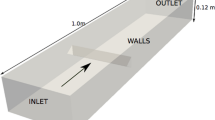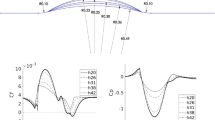Abstract
This study presents a comprehensive investigation into water jet injection dynamics in supersonic crossflows, employing a hybrid approach that integrates machine learning techniques, specifically random forest, with traditional discrete phase methods. The aim is to accurately model water jet structures and understand the underlying dynamics for optimizing flow control strategies. Through extensive numerical analysis, the study examines the influence of key parameters such as pressure levels, Weber number, droplet diameter and water jet velocity on penetration depth. Additionally, machine learning techniques are employed to analyze the impact of momentum, mass flow, pressure, Mach number and injection angle on penetration height. The findings reveal intricate interactions between pressure levels and penetration depth, driven by factors such as momentum transfer, evaporation efficiency and shock wave behavior. A direct correlation is observed between Weber number and penetration depth, emphasizing the role of inertial forces in determining penetration characteristics. Droplet diameter and water jet velocity emerge as critical factors affecting penetration depth, with smaller droplets and higher velocities resulting in deeper penetration into the crossflow. Machine learning analysis highlights the significance of momentum in influencing penetration height, while also indicating comparable effects of pressure, Mach number and injection angle. The random forest model demonstrates robust performance, achieving an accuracy exceeding 86.7% with an average absolute error of 0.00282, underscoring its reliability in predicting infiltration height.













Similar content being viewed by others
Data availability statement
The data that support the findings of this study are available upon request. Please contact Seyed Hamed Godasiaei for access to the data.
Abbreviations
- d :
-
Droplet's diameter
- d 0 :
-
The diameter of the injector orifice
- h :
-
Penetration height (spray)
- L :
-
Nozzle passage length
- M :
-
Mach number
- q . :
-
Ratio of jet to freestream momentum flux [\(\rho_{\rm L} w_{\rm j}^{2} /\rho_{\infty } u_{\infty }^{2}\)]
- u :
-
Velocity in the direction of X (m/s)
- w :
-
Velocity in the direction of Z (m/s)
- x :
-
Distance in the freestream direction
- SMD:
-
Sauter mean diameter
- C d :
-
Drag coefficient
- h :
-
Height of fluid jet penetration
- n :
-
Distribution shape parameter
- v :
-
Dynamic viscosity (kg m−1s−1)
- ρ :
-
Fluid density (kg m−3)
- θ :
-
Jet injection angle
- Pr:
-
Prandtl number
- Nu:
-
Nusselt number
- p :
-
Pressure (N/m2)
- Re:
-
Reynolds number
- t :
-
Time (s)
- T :
-
Temperature (K)
- Y d :
-
Density function of droplet size
- y :
-
Distance in the direction of the stream
- RF:
-
Random forest
- ML:
-
Machine learning model
- u* :
-
Velocity component
- ω :
-
Transport of the specific dissipation rate
- D :
-
Characteristic size parameter
- j :
-
Characteristic of liquid at injector exit
- L :
-
Liquid phase characteristic
- \(\infty\) :
-
Belonging to freestream
References
“LES of turbulent liquid jet primary breakup in turbulent coaxial air flow - ScienceDirect.” https://www.sciencedirect.com/science/article/pii/S0301932213001985. Accessed 31 March 2023.
F. Xiao, M. Dianat, J.J. McGuirk, LES of turbulent liquid jet primary breakup in turbulent coaxial air flow. Int. J. Multiph. Flow 60, 103–118 (Apr.2014). https://doi.org/10.1016/J.IJMULTIPHASEFLOW.2013.11.013
C. Li, P. Li, C. Li, Q. Li, Y. Zhou, Experimental and numerical investigation of cross-sectional structures of liquid jets in supersonic crossflow. Aerosp. Sci. Technol. 103, 105926 (2020). https://doi.org/10.1016/j.ast.2020.105926
J. Zhang, J. Chang, J. Ma, Y. Wang, W. Bao, Investigations on flame liftoff characteristics in liquid-kerosene fueled supersonic combustor equipped with thin strut. Aerosp. Sci. Technol. 84, 686–697 (2019). https://doi.org/10.1016/j.ast.2018.11.017
J. Zhang, J. Chang, W. Shi, W. Hou, W. Bao, Combustion stabilizations in a liquid kerosene fueled supersonic combustor equipped with an integrated pilot strut. Aerosp. Sci. Technol. 77, 83–91 (2018). https://doi.org/10.1016/j.ast.2018.02.035
J. Zhang, J. Chang, J. Ma, Y. Zhang, W. Bao, Local and global flame characteristics in a liquid kerosene fueled supersonic combustor equipped with a thin strut. Aerosp. Sci. Technol. 76, 49–57 (2018). https://doi.org/10.1016/j.ast.2018.02.007
Z. Ren, B. Wang, G. Xiang, D. Zhao, L. Zheng, Supersonic spray combustion subject to scramjets: progress and challenges. Prog. Aerosp. Sci. 105(June 2018), 40–59 (2019). https://doi.org/10.1016/j.paerosci.2018.12.002
J.T. Guerra, J.R. Edwards, K.C. Lin, “Improved Eulerian/Lagrangian modeling of liquid jet injection into a supersonic crossflow. AIAA Sci. Technol. Forum Expo. AIAA SciTech Forum 2022, 1–10 (2022). https://doi.org/10.2514/6.2022-1851
Z. Li, J. Leng, N.H. Abu-Hamdeh, A.M. Abusorrah, A. Musa, Effects of nozzle types on mass diffusion mechanism of hydrogen multi-jets at supersonic combustion chamber. Int. Commun. Heat Mass Transf. (2022). https://doi.org/10.1016/j.icheatmasstransfer.2022.106509
H. Sun, B. Bai, J. Yan, H. Zhang, Single-jet spray mixing with a confined crossflow. Chin. J. Chem. Eng. 21(1), 14–24 (2013). https://doi.org/10.1016/S1004-9541(13)60436-X
J. Zhao, Y.J. Ren, Y. Tong, W. Lin, W. Nie, Atomization of a liquid jet in supersonic crossflow in a combustion chamber with an expanded section. Acta Astronaut. 180(December 2020), 35–45 (2021). https://doi.org/10.1016/j.actaastro.2020.11.051
Y.Y. Niu, C.H. Wu, Y.H. Huang, Y.J. Chou, S.C. Kong, Evaluation of breakup models for liquid side jets in supersonic cross flows. Numer. Heat Transf. Part A Appl. 79(5), 353–369 (2020). https://doi.org/10.1080/10407782.2020.1847513
F.J. Salvador, J.V. Romero, M.D. Roselló, D. Jaramillo, Numerical simulation of primary atomization in diesel spray at low injection pressure. J. Comput. Appl. Math. 291, 94–102 (2016). https://doi.org/10.1016/j.cam.2015.03.044
P. Li et al., Three-dimensional flow structures and droplet-gas mixing process of a liquid jet in supersonic crossflow. Aerosp. Sci. Technol. 90, 140–156 (2019). https://doi.org/10.1016/j.ast.2019.04.024
C. Shao, K. Luo, Y. Yang, J. Fan, Detailed numerical simulation of swirling primary atomization using a mass conservative level set method. Int. J. Multiph. Flow 89, 57–68 (2017). https://doi.org/10.1016/j.ijmultiphaseflow.2016.10.010
Y. Zhao, J. Wu, X. Mu, Atomization characteristics of kerosene in crossflow with an incident shock wave. Aerospace (2023). https://doi.org/10.3390/aerospace10010030
G. Tomar, D. Fuster, S. Zaleski, S. Popinet, Multiscale simulations of primary atomization. Comput. Fluids 39(10), 1864–1874 (2010). https://doi.org/10.1016/j.compfluid.2010.06.018
P. Shi, G. Zhu, J. Cheng, J. Li, X. Hou, Simulation on atomization process of gas–liquid pintle injector in LRE under periodic conditions based on the VOF to DPM method. Aerosp. Sci. Technol. 136, 108222 (2023). https://doi.org/10.1016/j.ast.2023.108222
F. Leboeuf, J.C. Marongiu, Smoothed-particle hydrodynamics (SPH) methods. Comput. Fluid Dyn. 50, 63–85 (2011). https://doi.org/10.1201/B11033-9/SMOOTHED-PARTICLE-HYDRODYNAMICS-SPH-METHODS-FRANCIS-LEBOEUF-JEAN-CHRISTOPHE-MARONGIU
“Smoothed-particle hydrodynamics (SPH) methods | 9 | Computational Flui.” https://www.taylorfrancis.com/chapters/edit/https://doi.org/10.1201/b11033-9/smoothed-particle-hydrodynamics-sph-methods-francis-leboeuf-jean-christophe-marongiu. Accessed 31 March 2023.
K.C. Lin, P.J. Kennedy, T.A. Jackson, Structures of water jets in a mach 1.94 supersonic crossflow. AIAA Pap. (2004). https://doi.org/10.2514/6.2004-971
M.S. Almanzalawy, L.H. Rabie, M.H. Mansour, Modeling of an efficient airblast atomizer for liquid jet into a supersonic crossflow. Acta Astronaut. 177(March), 142–157 (2020). https://doi.org/10.1016/j.actaastro.2020.07.031
M. He, G. Zhang, S. Hu, C. Wang, Assessment of a method to enhance the momentum of water mist: co-flow jet water mist system. Fire Technol. 58(1), 435–455 (2022). https://doi.org/10.1007/s10694-021-01128-8
A.C. Ispir, K. Zdybał, B.H. Saracoglu, T. Magin, A. Parente, A. Coussement, Reduced-order modeling of supersonic fuel–air mixing in a multi-strut injection scramjet engine using machine learning techniques. Acta Astronaut. 202, 564–584 (2023). https://doi.org/10.1016/J.ACTAASTRO.2022.11.013
R. Liebeck, T.B. Company, and L. Beach, “Transport 40th AIAA Aerospace Sciences Meeting & Exhibit 14–17 January 2002 / Reno , NV,” no. January, 2002.
A.S. Nejad, J. Schetz, A.K. Jakubowski, A. Schetz, and A. Jakubowski, “Mean droplet diameter resulting from atomization of a transverse liquid jet in a supersonic airstream ‘Global Technology 2000’ Mean Droplet Diameter Resulting From Atomization of a Transverse Liquid Jet in a Supersonic Air Stream*,” 2000.
L. Bravo and C. Kweon, “A review on liquid spray models for diesel engine computational analysis (DROPLET BREAKUP),” Army Res. Lab., vol. 6932, no. May, p. 54, 2014.
X. Fan, J. Wang, A marker-based Eulerian-Lagrangian Method for multiphase flow with supersonic combustion applications. Int. J. Mod. Phys. Conf. Ser. 42, 1660159 (2016). https://doi.org/10.1142/s2010194516601599
D.T. Gawne, B. Liu, Y. Bao, T. Zhang, Modelling of plasma-particle two-phase flow using statistical techniques. Surf. Coat. Technol. 191(2–3), 242–254 (2005). https://doi.org/10.1016/j.surfcoat.2004.02.032
M. Turbulence, “Standard , RNG , and Realizable k-Models Theory Standard k-Model Overview Transport Equations for the Standard k-Model Modeling the Turbulent Viscosity,” pp. 12–26, 2006, [Online]. Available: https://courses.washington.edu/mengr544/handouts-10/Fluent-k-epsilon.pdf.
X. Fan, J. Wang, F. Zhao, J. Li, T. Yang, Eulerian–Lagrangian method for liquid jet atomization in supersonic crossflow using statistical injection model. Adv. Mech. Eng. 10(2), 1–13 (2018). https://doi.org/10.1177/1687814018761295
P.A. Vesilind, The Rosin–Rammler particle size distribution. Resour. Recover. Conserv. 5(3), 275–277 (Sep.1980). https://doi.org/10.1016/0304-3967(80)90007-4
P.K. Senecal, D.P. Schmidt, I. Nouar, C.J. Rutland, R.D. Reitz, M.L. Corradini, Modeling high-speed viscous liquid sheet atomization. Int. J. Multiph. Flow 25(6–7), 1073–1097 (1999). https://doi.org/10.1016/S0301-9322(99)00057-9
F.A. Williams, Spray combustion and atomization. Phys. Fluids 1(6), 541–545 (1958). https://doi.org/10.1063/1.1724379
P. Sharma, K. Ramesh, R. Parameshwaran, and S. S. Deshmukh, “Thermal conductivity prediction of titania-water nanofluid: A case study using different machine learning algorithms,” Case Stud. Therm. Eng., vol. 30, no. November 2021, p. 101658, 2022, https://doi.org/10.1016/j.csite.2021.101658.
A. Marani, M.L. Nehdi, Machine learning prediction of compressive strength for phase change materials integrated cementitious composites. Constr. Build. Mater. 265, 120286 (2020). https://doi.org/10.1016/j.conbuildmat.2020.120286
J. Mohammadpour, S. Husain, F. Salehi, A. Lee, Machine learning regression-CFD models for the nanofluid heat transfer of a microchannel heat sink with double synthetic jets. Int. Commun. Heat Mass Transf. 130, 105808 (2022). https://doi.org/10.1016/j.icheatmasstransfer.2021.105808
F. Saffarimiandoab, R. Mattesini, W. Fu, E. E. Kuruoglu, and X. Zhang, “Insights on features’ contribution to desalination dynamics and capacity of capacitive deionization through machine learning study,” Desalination, vol. 515, no. June, p. 115197, 2021, https://doi.org/10.1016/j.desal.2021.115197
F. Saffarimiandoab, R. Mattesini, W. Fu, E.E. Kuruoglu, X. Zhang, Interpretable machine learning modeling of capacitive deionization for contribution analysis of electrode and process features. J. Mater. Chem. A 9(4), 2259–2268 (2021). https://doi.org/10.1039/d0ta09531a
S. H. Godasiaei and A. J. Chamkha, “Numerical Heat Transfer , Part A : Applications Advancing heat transfer modeling through machine learning : A focus on forced convection with nanoparticles,” Numer. Heat Transf. Part A Appl., vol. 0, no. 0, pp. 1–23, 2024, https://doi.org/10.1080/10407782.2023.2299734.
成科扬 et al., “深度学习可解释性研究进展,” 计算机研究与发展, vol. 32, no. 2, pp. 1208–1217, 2019, [Online]. https://doi.org/10.1016/j.inffus.2019.12.012%0A10.1016/j.ophtha.2018.11.016.
C. Ghenai, H. Sapmaz, C.X. Lin, Penetration height correlations for non-aerated and aerated transverse liquid jets in supersonic cross flow. Exp. Fluids 46(1), 121–129 (2009). https://doi.org/10.1007/s00348-008-0547-8
Funding
The authors declare that they have no known competing financial interests or personal relationships that could have appeared to influence the work reported in this paper.
Author information
Authors and Affiliations
Contributions
Seyed Hamed Godasiaei conceived and designed the study, collected and analyzed the data, contributed to the interpretation of the results and drafted the manuscript. The authors critically revised and approved the final version.
Corresponding author
Ethics declarations
Competing interests
The authors declare that they have no competing interests.
Ethical statement
This study was conducted in accordance with ethical standards and guidelines. The study protocol was followed, and all participants provided informed consent.
Rights and permissions
Springer Nature or its licensor (e.g. a society or other partner) holds exclusive rights to this article under a publishing agreement with the author(s) or other rightsholder(s); author self-archiving of the accepted manuscript version of this article is solely governed by the terms of such publishing agreement and applicable law.
About this article
Cite this article
Godasiaei, S.H., Kamali, H. Water jet angle prediction in supersonic crossflows: Euler–Lagrange and machine learning approaches. Eur. Phys. J. Plus 139, 251 (2024). https://doi.org/10.1140/epjp/s13360-024-05047-9
Received:
Accepted:
Published:
DOI: https://doi.org/10.1140/epjp/s13360-024-05047-9




